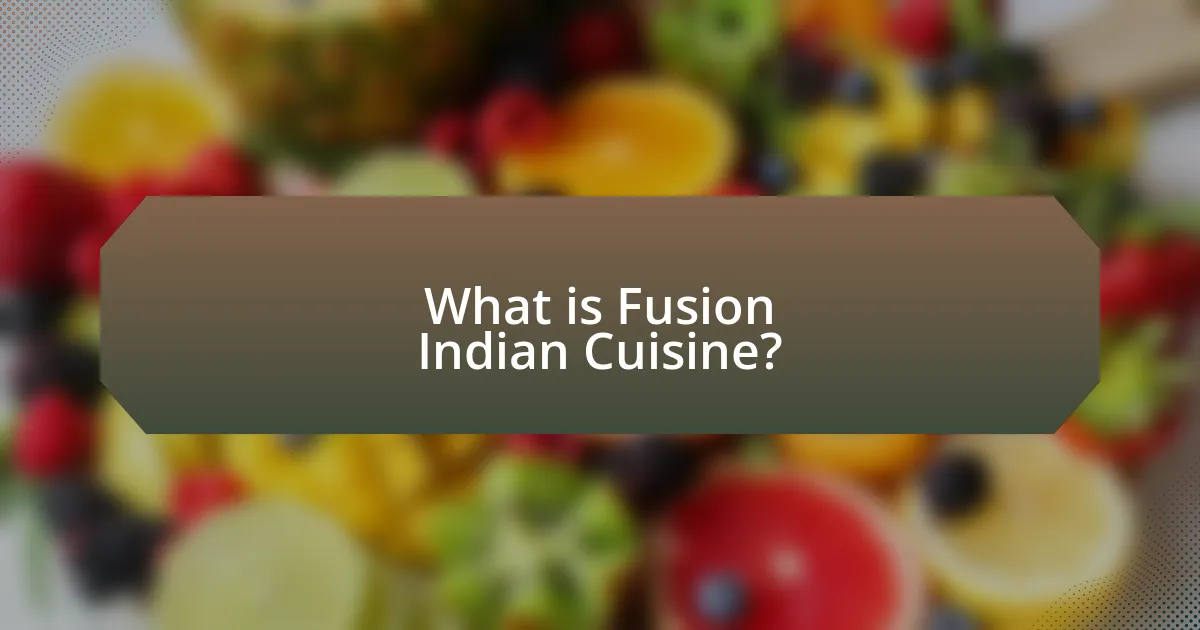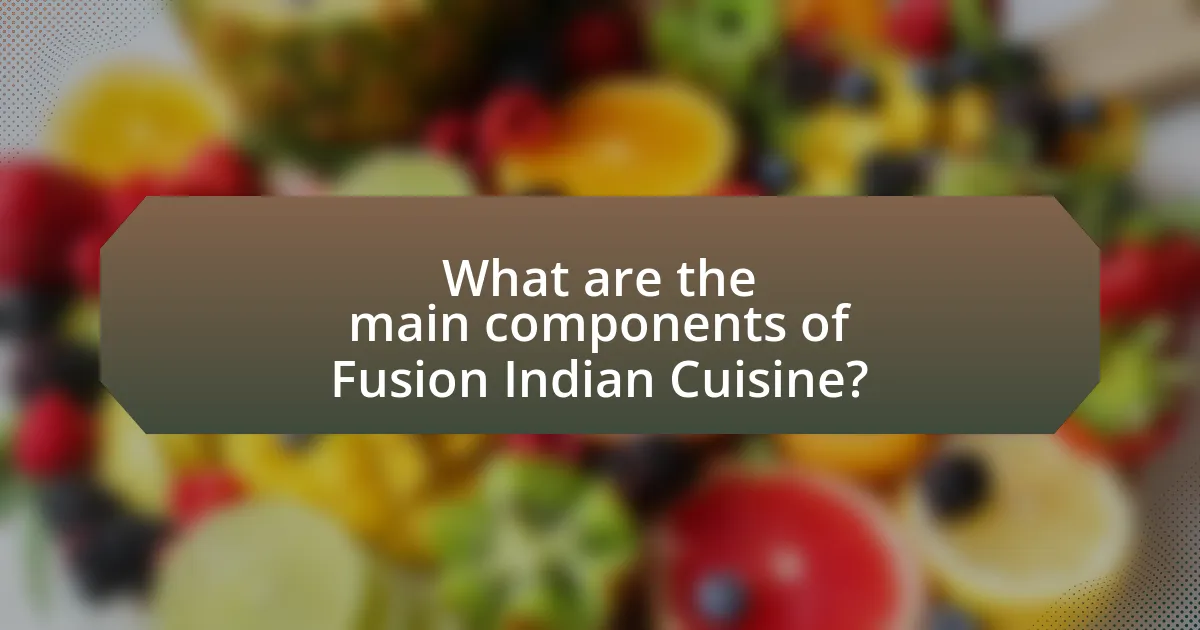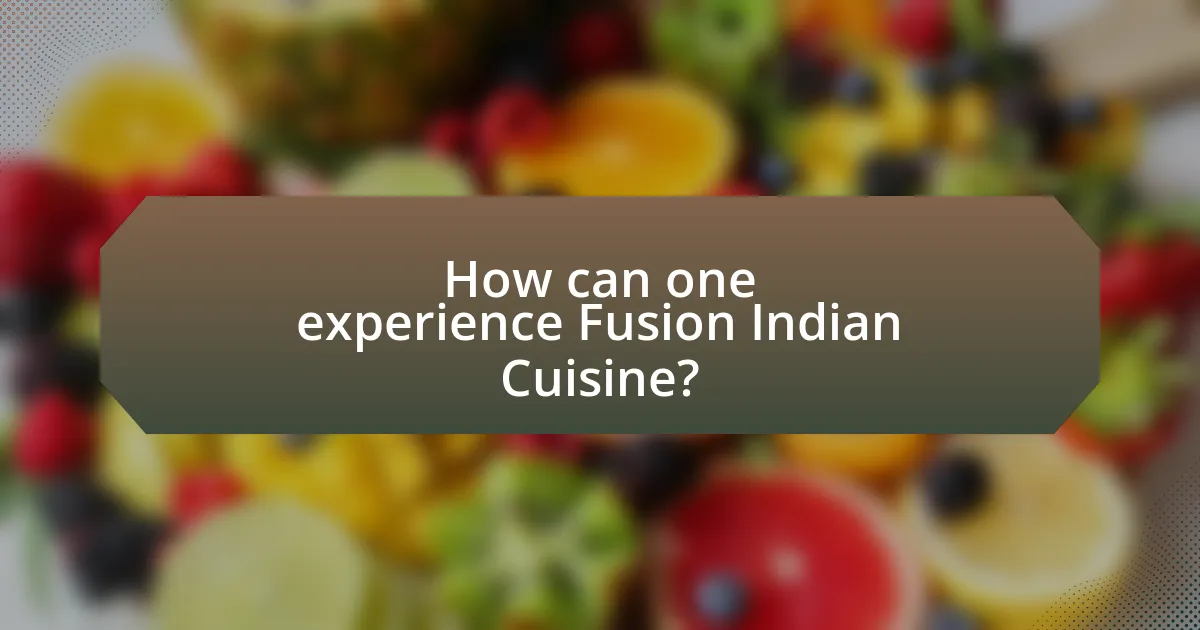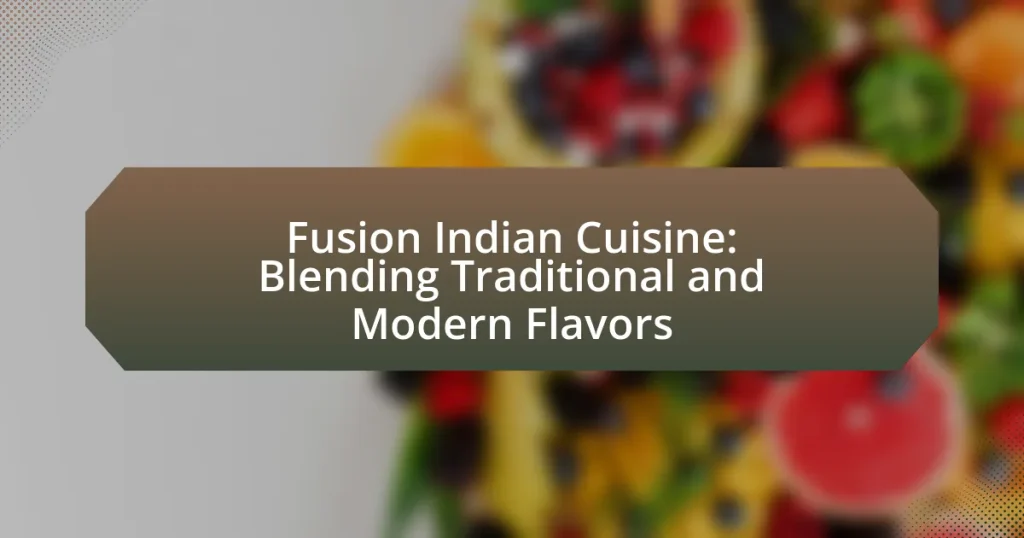Fusion Indian Cuisine is a culinary style that merges traditional Indian cooking techniques and flavors with elements from various global cuisines, resulting in innovative dishes that appeal to diverse palates. This article explores the differences between Fusion Indian Cuisine and traditional Indian cuisine, highlighting key characteristics, modern influences, and the impact of globalization on its evolution. It also discusses popular fusion dishes, essential ingredients, and cooking techniques, while providing insights into the cultural factors driving its rising popularity. Additionally, the article offers tips for experiencing and recreating Fusion Indian dishes at home, emphasizing the importance of balancing flavors and selecting compatible ingredients.

What is Fusion Indian Cuisine?
Fusion Indian Cuisine is a culinary style that combines traditional Indian cooking techniques and flavors with elements from other global cuisines. This approach often results in innovative dishes that reflect a blend of cultural influences, such as Indian spices paired with Western cooking methods or ingredients from Asian or Mediterranean cuisines. The popularity of Fusion Indian Cuisine has grown, particularly in urban areas, as chefs experiment with diverse ingredients and presentation styles, creating unique dining experiences that appeal to a wide range of palates.
How does Fusion Indian Cuisine differ from traditional Indian cuisine?
Fusion Indian Cuisine differs from traditional Indian cuisine primarily in its incorporation of diverse culinary influences and innovative techniques. While traditional Indian cuisine is characterized by its regional ingredients, specific cooking methods, and adherence to age-old recipes, Fusion Indian Cuisine blends these elements with flavors and techniques from other global cuisines, such as Italian, Mexican, or Asian. This results in unique dishes that may combine traditional Indian spices with non-Indian ingredients, creating a novel dining experience. For example, a popular fusion dish might be a curry pizza, which merges the concept of pizza with Indian curry flavors, showcasing the adaptability and creativity inherent in Fusion Indian Cuisine.
What are the key characteristics of traditional Indian cuisine?
Traditional Indian cuisine is characterized by its diverse use of spices, regional variations, and a focus on vegetarianism. The extensive use of spices such as cumin, coriander, turmeric, and cardamom not only enhances flavor but also contributes to health benefits, as many spices possess medicinal properties. Additionally, regional variations reflect the geography, climate, and cultural influences across India, resulting in distinct culinary practices. For instance, North Indian cuisine often features rich gravies and breads, while South Indian cuisine is known for its rice-based dishes and coconut usage. Furthermore, vegetarianism is prevalent due to cultural and religious beliefs, with a significant portion of the population adhering to vegetarian diets, which has led to the development of a wide array of vegetarian dishes.
What modern influences shape Fusion Indian Cuisine?
Modern influences that shape Fusion Indian Cuisine include globalization, culinary innovation, and the integration of diverse cultural elements. Globalization has facilitated the exchange of culinary techniques and ingredients, allowing chefs to experiment with traditional Indian flavors alongside international cuisines. Culinary innovation drives the creation of new dishes that blend Indian spices with Western cooking methods, such as using tandoori techniques in pizza or incorporating Indian spices into pasta. Additionally, the influence of social media and food trends encourages chefs to showcase visually appealing dishes that attract a global audience, further blending traditional Indian cuisine with contemporary dining experiences.
Why is Fusion Indian Cuisine gaining popularity?
Fusion Indian Cuisine is gaining popularity due to its innovative blend of traditional Indian flavors with global culinary influences. This trend appeals to diverse palates, as it offers unique dishes that combine familiar Indian spices with ingredients and techniques from other cuisines, such as Italian, Mexican, and Asian. The rise of social media and food blogging has further amplified this trend, allowing chefs to showcase their creative dishes and attract a wider audience. Additionally, the increasing interest in experiential dining encourages consumers to seek out novel food experiences, making fusion cuisine an attractive option for adventurous eaters.
What cultural factors contribute to the rise of Fusion Indian Cuisine?
Cultural factors contributing to the rise of Fusion Indian Cuisine include globalization, migration, and the blending of culinary traditions. Globalization has facilitated the exchange of ideas and ingredients across borders, allowing chefs to experiment with diverse flavors and techniques. Migration has introduced various cultural influences into Indian cuisine, as communities bring their culinary heritage, leading to innovative combinations. Additionally, the increasing interest in health-conscious eating has prompted chefs to adapt traditional recipes with modern, healthier ingredients, further driving the evolution of Fusion Indian Cuisine.
How does globalization impact the evolution of Fusion Indian Cuisine?
Globalization significantly influences the evolution of Fusion Indian Cuisine by facilitating the exchange of culinary techniques and ingredients across cultures. This interaction allows Indian chefs to incorporate diverse flavors and cooking methods from various global cuisines, leading to innovative dishes that blend traditional Indian elements with international influences. For instance, the rise of Indian-inspired tacos or sushi rolls filled with spiced vegetables exemplifies this fusion. Additionally, globalization has expanded access to international ingredients, enabling chefs to experiment and create unique flavor profiles that reflect a global palate. The increasing popularity of Indian cuisine worldwide further drives this evolution, as chefs adapt traditional recipes to cater to diverse tastes and dietary preferences, thus continuously reshaping the culinary landscape.

What are the main components of Fusion Indian Cuisine?
The main components of Fusion Indian Cuisine include traditional Indian spices, cooking techniques, and ingredients combined with elements from other culinary traditions. This cuisine often features dishes that incorporate global flavors, such as Italian, Chinese, or Mexican, while maintaining the essence of Indian cooking. For example, a popular dish might be a curry infused with Italian herbs or a dosa filled with Mexican-style beans. The blending of these diverse elements creates innovative dishes that appeal to a wide range of palates, showcasing the versatility and adaptability of Indian cuisine.
What ingredients are commonly used in Fusion Indian Cuisine?
Common ingredients in Fusion Indian Cuisine include spices like cumin, coriander, and turmeric, along with modern elements such as avocado, quinoa, and various cheeses. These ingredients reflect a blend of traditional Indian flavors with contemporary culinary trends, creating innovative dishes that appeal to diverse palates. The use of spices provides the foundational taste characteristic of Indian cuisine, while the incorporation of modern ingredients allows for unique interpretations and presentations, exemplifying the versatility and creativity inherent in Fusion Indian cooking.
How do traditional Indian spices blend with international flavors?
Traditional Indian spices blend with international flavors through the process of fusion cuisine, where spices like cumin, coriander, and turmeric are combined with ingredients and cooking techniques from various global culinary traditions. This blending enhances dishes by introducing complex flavor profiles; for example, turmeric is often used in Western dishes to add color and health benefits, while cumin complements Mexican and Middle Eastern cuisines. The adaptability of Indian spices allows chefs to create innovative recipes that appeal to diverse palates, as seen in dishes like curry-infused risotto or tandoori chicken tacos. This culinary exchange not only enriches the dining experience but also reflects the growing trend of globalization in food culture.
What role do fresh ingredients play in Fusion Indian dishes?
Fresh ingredients are essential in Fusion Indian dishes as they enhance flavor, texture, and nutritional value. The use of fresh herbs, vegetables, and spices allows chefs to create vibrant and aromatic dishes that reflect both traditional Indian cuisine and modern culinary trends. For instance, fresh cilantro and mint are often incorporated to provide a refreshing contrast to rich, spiced elements, while seasonal vegetables can introduce new textures and colors, making the dish visually appealing and healthful. Studies show that fresh ingredients can significantly improve the overall taste profile and health benefits of meals, thereby elevating the dining experience in Fusion Indian cuisine.
What cooking techniques are prevalent in Fusion Indian Cuisine?
Fusion Indian Cuisine employs a variety of cooking techniques that blend traditional Indian methods with modern culinary practices. Techniques such as grilling, sous-vide, and molecular gastronomy are prevalent, allowing chefs to create innovative dishes that maintain the essence of Indian flavors while incorporating contemporary styles. For instance, grilling is often used to enhance the smoky flavors of marinated meats, while sous-vide allows for precise temperature control, resulting in tender and flavorful dishes. Molecular gastronomy introduces elements like foams and gels, transforming traditional ingredients into new textures and presentations. These techniques exemplify the creative fusion of culinary traditions, showcasing the versatility and adaptability of Indian cuisine in a modern context.
How do modern cooking methods enhance traditional recipes?
Modern cooking methods enhance traditional recipes by introducing techniques that improve flavor extraction, texture, and presentation. For instance, sous-vide cooking allows for precise temperature control, resulting in meats that are tender and evenly cooked, which can elevate traditional dishes like biryani or curry. Additionally, methods such as molecular gastronomy can transform the presentation and mouthfeel of classic recipes, making them more appealing and innovative while retaining their original essence. These advancements not only preserve the cultural significance of traditional recipes but also adapt them to contemporary palates, ensuring their relevance in modern cuisine.
What innovative techniques are being introduced in Fusion Indian cooking?
Innovative techniques being introduced in Fusion Indian cooking include molecular gastronomy, sous-vide cooking, and the use of international spices and ingredients. Molecular gastronomy allows chefs to deconstruct traditional dishes and present them in new forms, such as using foams or gels to enhance flavors. Sous-vide cooking provides precise temperature control, ensuring that meats and vegetables retain their moisture and flavor, which is particularly beneficial for traditional Indian curries. Additionally, the incorporation of global ingredients, such as quinoa or avocado, into classic Indian recipes reflects a blending of culinary traditions, creating unique flavor profiles that appeal to modern palates. These techniques are reshaping the culinary landscape by merging traditional Indian cooking methods with contemporary culinary innovations.

How can one experience Fusion Indian Cuisine?
To experience Fusion Indian Cuisine, one should visit restaurants that specialize in this culinary style, where traditional Indian flavors are combined with elements from other global cuisines. Many chefs in these establishments creatively blend spices and cooking techniques from various cultures, resulting in unique dishes such as tandoori tacos or curry-infused risottos. This approach not only showcases the versatility of Indian ingredients but also reflects the growing trend of culinary innovation, as evidenced by the increasing number of fusion restaurants worldwide, which cater to diverse palates and preferences.
What are some popular Fusion Indian dishes to try?
Some popular Fusion Indian dishes to try include Tandoori Chicken Tacos, Butter Chicken Pizza, and Masala Quesadilla. Tandoori Chicken Tacos combine traditional Indian marinated chicken with Mexican-style tortillas, creating a unique flavor profile. Butter Chicken Pizza merges the classic Indian butter chicken with Italian pizza, offering a rich and creamy topping. Masala Quesadilla features Indian spices and ingredients in a traditional quesadilla format, providing a spicy twist to a Mexican favorite. These dishes exemplify the blending of traditional Indian flavors with global culinary techniques.
How do these dishes reflect the blending of cultures?
Fusion Indian cuisine reflects the blending of cultures by incorporating diverse culinary techniques and ingredients from various global traditions into traditional Indian dishes. For example, the use of Italian cheeses in Indian curries or the infusion of Mexican spices in biryanis showcases how chefs creatively merge flavors and cooking methods from different cultures. This culinary fusion not only enhances the taste but also symbolizes the interconnectedness of global food practices, as seen in the popularity of dishes like tandoori pizza, which combines Indian tandoori cooking with Italian pizza-making. Such innovations highlight the adaptability of Indian cuisine and its ability to evolve by embracing influences from around the world.
What are the best restaurants known for Fusion Indian Cuisine?
The best restaurants known for Fusion Indian Cuisine include Junoon in New York City, which combines traditional Indian flavors with modern techniques, and Dishoom in London, celebrated for its innovative take on Indian street food. These establishments have garnered acclaim for their unique dishes that blend Indian spices with global culinary influences, such as Junoon’s tandoori octopus and Dishoom’s bacon naan roll. Their popularity is evidenced by numerous awards and positive reviews from food critics, highlighting their role in redefining Indian cuisine through fusion.
What tips can enhance your experience with Fusion Indian Cuisine?
To enhance your experience with Fusion Indian Cuisine, explore a variety of dishes that combine traditional Indian flavors with modern culinary techniques. This approach allows you to appreciate the unique blend of spices and ingredients that define fusion cuisine. For instance, trying dishes like tandoori chicken tacos or paneer tikka quesadillas showcases the versatility of Indian flavors in a contemporary format. Additionally, pairing fusion dishes with complementary beverages, such as craft cocktails infused with Indian spices, can elevate the overall dining experience. Engaging with the chef or staff about the inspiration behind the dishes can also provide deeper insights into the culinary creativity involved, enriching your understanding and enjoyment of the meal.
How can you recreate Fusion Indian dishes at home?
To recreate Fusion Indian dishes at home, start by combining traditional Indian ingredients with elements from other cuisines, such as using spices like cumin and coriander in a pasta dish or incorporating Indian flavors into tacos. For example, you can make a butter chicken pizza by using naan as the base and topping it with butter chicken sauce and cheese. This approach allows for the blending of flavors while maintaining the essence of Indian cuisine. The popularity of fusion dishes, such as tikka masala burritos, demonstrates the successful integration of diverse culinary traditions, making it easier to experiment with various combinations at home.
What are some common mistakes to avoid when cooking Fusion Indian Cuisine?
Common mistakes to avoid when cooking Fusion Indian Cuisine include neglecting the balance of flavors, using incompatible ingredients, and overcomplicating dishes. Maintaining a harmonious blend of spices is crucial, as Indian cuisine relies heavily on flavor balance; failing to do so can result in overpowering or bland dishes. Additionally, selecting ingredients that do not complement each other can lead to unappetizing outcomes; for instance, pairing delicate flavors with strong spices without consideration can clash. Lastly, overcomplicating recipes by adding too many elements can detract from the essence of both traditional and modern influences, making the dish confusing rather than cohesive.
